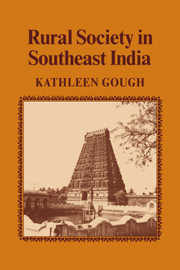Book contents
- Frontmatter
- Contents
- Preface
- Part I Thanjāvūr
- Part II Kumbapeṭṭai
- 8 The Face of the Village
- 9 Kumbapeṭṭai before 1855
- 10 Kumbapeṭṭai from 1855 to 1952
- 11 The Annual Round
- 12 Economics and Class Structure: The Petty Bourgeoisie
- 13 Independent Commodity Producers and Traders
- 14 The Semiproletariat
- 15 Village Politics: Religion, Caste, and Class
- 16 Village Politics: The Street Assembly
- 17 Class Struggle and Village Power Structure
- Part III Kirippūr
- Notes
- Glossary
- Bibliography
- Index
- CAMBRIDGE STUDIES IN SOCIAL ANTHROPOLOGY
8 - The Face of the Village
from Part II - Kumbapeṭṭai
Published online by Cambridge University Press: 29 October 2009
- Frontmatter
- Contents
- Preface
- Part I Thanjāvūr
- Part II Kumbapeṭṭai
- 8 The Face of the Village
- 9 Kumbapeṭṭai before 1855
- 10 Kumbapeṭṭai from 1855 to 1952
- 11 The Annual Round
- 12 Economics and Class Structure: The Petty Bourgeoisie
- 13 Independent Commodity Producers and Traders
- 14 The Semiproletariat
- 15 Village Politics: Religion, Caste, and Class
- 16 Village Politics: The Street Assembly
- 17 Class Struggle and Village Power Structure
- Part III Kirippūr
- Notes
- Glossary
- Bibliography
- Index
- CAMBRIDGE STUDIES IN SOCIAL ANTHROPOLOGY
Summary
In Part I, I analyzed the political economy and historical background of Thanjāvūr district as a whole. In Part II, I turn to the microlevel and describe Kumbapeṭṭai, a village in northwest Thanjāvūr, as it was in 1951–2. My focus is on the political economy of the village, especially the changing structures of caste and class.
The External Setting
Kumbapeṭṭai lay on a main bus route a few miles from the town of Thanjāvūr, slightly south of the main branch of the River Kāvēri. Its chief trading and shopping center was Āriyūr, a market town of about 9,000, three miles to the northeast. In August 1952, Kumbapeṭṭai's population was 817. The total acreage of the main socioeconomic unit was about 522 acres, some 90 percent of it being wet paddy land. Kumbapeṭṭai was a grāmam, that is, a village traditionally owned and governed by Brahmans.
Kumbapeṭṭai had two hamlets, or “side-villages,” attached to it, whose populations and areas are not included in these figures (see Map 3). The houses in Veliyūr lay about half a mile to the north and those in Sheṭṭ;yūr about three-quarters of a mile to the west. In 1952, Veḷiyūr, with 117 acres, had about 110 people, mainly Roman Catholic Pallars on one street and Hindu Pallars on another. Both served an absent Veḷḷāḷar landlord. Sheṭṭiyur, with about eightyfour acres, had about 125 people, mainly Veḷḷāḷar owner cultivators and Muppanar tenants. Shettiyur drew its Harijan laborers from Kandipeṭṭai, a village to the northwest.
- Type
- Chapter
- Information
- Rural Society in Southeast India , pp. 151 - 173Publisher: Cambridge University PressPrint publication year: 1982

